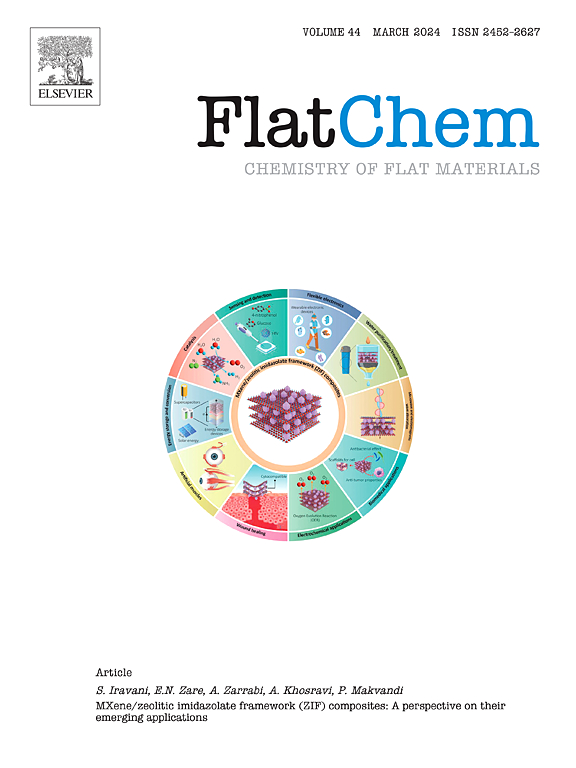通过掺杂钕增强钛酸铋纳米片的宏观极化,实现污染物的高效压电光催化降解
IF 5.9
3区 材料科学
Q2 CHEMISTRY, PHYSICAL
引用次数: 0
摘要
最近,压电光催化引起了科学界的极大兴趣。压电场可促进光生电子-空穴对的分离,从而显著提高材料的光催化效率。本研究通过水热技术制备了 Bi4-xNdxTi3O12(x = 0、0.5、0.75、1.0,xNd-BTO)纳米片,并将其用作压电光催化剂来降解罗丹明 B(RhB)和双氯芬酸钠(DS)。在所有样品中,0.75Nd-BTO 的压电光催化效率最高,仅在 25 分钟内就实现了 RhB 的完全降解,表观速率常数为 0.2151 min-1。这一活性约为原始 BTO 的 9.31 倍,超过了大多数已报道的压电光催化剂的性能。适量的掺杂钕增加了比表面积,优化了能带结构,并促进了压电效应和光催化效应的耦合,从而使 0.75Nd-BTO 具有优异的压电光催化活性。本研究表明,掺杂适量的 Nd3+ 可以显著提高压电材料的压电光催化性能,这为未来设计高效的压电光催化剂提供了一条可行的途径。本文章由计算机程序翻译,如有差异,请以英文原文为准。

Enhanced macroscopic polarization in bismuth titanate nanosheets for efficient piezo-photocatalytic degradation of pollutants by Nd doping
Recently, piezo-photocatalysis has attracted great scientific interest, in which a piezoelectric field promotes the separation of photogenerated electron-hole pairs, thereby significantly enhancing the photocatalytic efficiency of the material. In this study, Bi4-xNdxTi3O12 (x = 0, 0.5, 0.75, 1.0, xNd-BTO) nanosheets were fabricated through a hydrothermal technique and employed as piezo-photocatalysts to degrade Rhodamine B (RhB) and diclofenac sodium (DS). Across all samples, 0.75Nd-BTO exhibited the highest piezo-photocatalytic efficiency, achieving complete RhB degradation in just 25 min, with an apparent rate constant of 0.2151 min−1. This activity was approximately 9.31 times greater than that of pristine BTO, surpassing the performance of most piezo-photocatalysts reported. The appropriate amount of Nd doping increases the specific surface area, optimizes energy band structure, as well as promotes the coupling of piezoelectric and photocatalytic effects, which contribute to the excellent piezo-photocatalytic activity of 0.75Nd-BTO. In this work, it is shown that doping with appropriate amounts of Nd3+ can significantly improve the piezo-photocatalytic performance of piezoelectrics, which provides a feasible way to design efficient piezo-photocatalysts in the future.
求助全文
通过发布文献求助,成功后即可免费获取论文全文。
去求助
来源期刊

FlatChem
Multiple-
CiteScore
8.40
自引率
6.50%
发文量
104
审稿时长
26 days
期刊介绍:
FlatChem - Chemistry of Flat Materials, a new voice in the community, publishes original and significant, cutting-edge research related to the chemistry of graphene and related 2D & layered materials. The overall aim of the journal is to combine the chemistry and applications of these materials, where the submission of communications, full papers, and concepts should contain chemistry in a materials context, which can be both experimental and/or theoretical. In addition to original research articles, FlatChem also offers reviews, minireviews, highlights and perspectives on the future of this research area with the scientific leaders in fields related to Flat Materials. Topics of interest include, but are not limited to, the following: -Design, synthesis, applications and investigation of graphene, graphene related materials and other 2D & layered materials (for example Silicene, Germanene, Phosphorene, MXenes, Boron nitride, Transition metal dichalcogenides) -Characterization of these materials using all forms of spectroscopy and microscopy techniques -Chemical modification or functionalization and dispersion of these materials, as well as interactions with other materials -Exploring the surface chemistry of these materials for applications in: Sensors or detectors in electrochemical/Lab on a Chip devices, Composite materials, Membranes, Environment technology, Catalysis for energy storage and conversion (for example fuel cells, supercapacitors, batteries, hydrogen storage), Biomedical technology (drug delivery, biosensing, bioimaging)
 求助内容:
求助内容: 应助结果提醒方式:
应助结果提醒方式:


